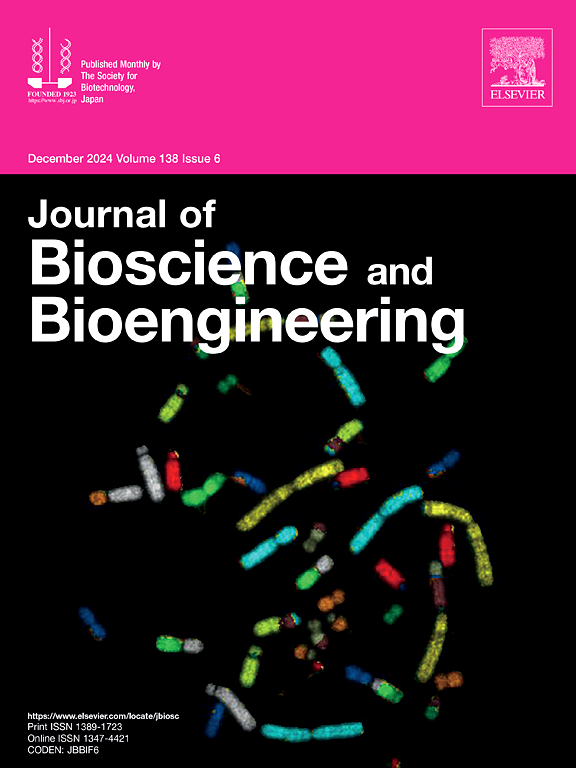Comparative metabolome analysis of sake yeast with enhanced fermentation performance in sake fermentation conditions
IF 2.9
4区 生物学
Q3 BIOTECHNOLOGY & APPLIED MICROBIOLOGY
引用次数: 0
Abstract
Japanese sake is fermented with specific strains of budding yeast Saccharomyces cerevisiae. Sake yeasts can allow the ethanol concentration of sake to exceed 20 % without distillation. While the genetic mutations responsible for these exceptional properties have been investigated, the underlying metabolism has not been fully explored. It is because yeast cells cultured in sake mash are difficult to collect for metabolome analysis. This study aimed to clarify the metabolic differences of K701 sake yeast and the X2180 diploid laboratory strain when cultured under sake fermentation conditions. To find an alternative medium that mimics sake fermentation and is applicable to measurements of intracellular metabolome, we compared three liquid media, including SD2 medium (synthetic dextrose medium containing 2 % glucose), SD20 medium (synthetic dextrose medium containing 20 % glucose and 1.8 % lactic acid) and pseudo-sake medium (a supernatant of saccharified rice supplemented with 1.8 % lactic acid). Culture profile data demonstrated that the pseudo-sake medium successfully reproduced the metabolic traits of K701 observed in sake mash. Targeted metabolome analysis of yeast cells cultured in the pseudo-sake medium revealed that levels of glycolytic metabolites, such as glucose-6-phosphate (G6P), fructose-6-phosphate (F6P), and fructose-1,6-bisphosphate (FBP), were significantly higher with K701. Based on metabolite concentration data, we inferred that K701 cells had a higher ATP regeneration rate. Calculation of differential Gibbs free energy changes revealed that the glucokinase reaction was upregulated in K701. The present study has, for the first time, revealed the metabolism of K701 sake yeast responsible for its exceptional fermentation ability under sake fermentation conditions.
提高发酵性能的清酒酵母在清酒发酵条件下的代谢组比较分析。
日本清酒是用一种特殊的出芽酵母酿酒酵母发酵的。清酒酵母可以使清酒的乙醇浓度超过20%而无需蒸馏。虽然已经研究了导致这些特殊特性的基因突变,但潜在的代谢尚未得到充分探索。这是因为在清酒醪中培养的酵母细胞难以收集以进行代谢组学分析。本研究旨在阐明K701清酵母与X2180二倍体实验室菌株在清酒发酵条件下的代谢差异。为了找到一种模拟清酒发酵并适用于细胞内代谢组测量的替代培养基,我们比较了三种液体培养基,包括SD2培养基(含2%葡萄糖的合成葡萄糖培养基),SD20培养基(含20%葡萄糖和1.8%乳酸的合成葡萄糖培养基)和伪清培养基(添加1.8%乳酸的糖化大米上清液)。培养剖面数据表明,伪清酒培养基成功再现了K701在清酒醪中观察到的代谢性状。在伪清酒培养基中培养的酵母细胞的代谢组学分析显示,K701显著提高了糖酵解代谢产物的水平,如葡萄糖-6-磷酸(G6P)、果糖-6-磷酸(F6P)和果糖-1,6-二磷酸(FBP)。根据代谢物浓度数据,我们推断K701细胞具有更高的ATP再生率。吉布斯自由能变化的差异计算表明,葡萄糖激酶反应在K701中上调。本研究首次揭示了K701清酵母在清酒发酵条件下具有特殊发酵能力的代谢机制。
本文章由计算机程序翻译,如有差异,请以英文原文为准。
求助全文
约1分钟内获得全文
求助全文
来源期刊

Journal of bioscience and bioengineering
生物-生物工程与应用微生物
CiteScore
5.90
自引率
3.60%
发文量
144
审稿时长
51 days
期刊介绍:
The Journal of Bioscience and Bioengineering is a research journal publishing original full-length research papers, reviews, and Letters to the Editor. The Journal is devoted to the advancement and dissemination of knowledge concerning fermentation technology, biochemical engineering, food technology and microbiology.
 求助内容:
求助内容: 应助结果提醒方式:
应助结果提醒方式:


